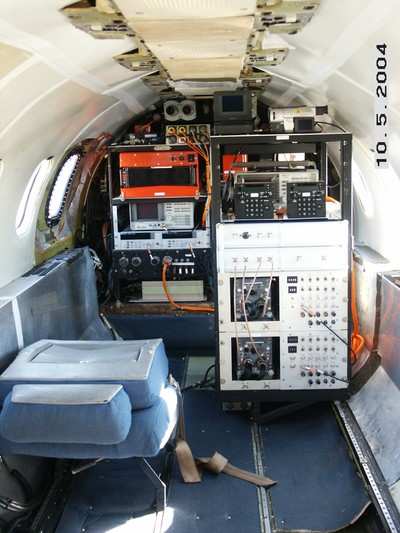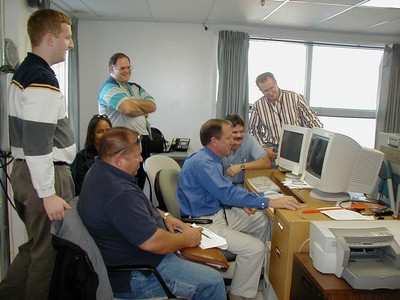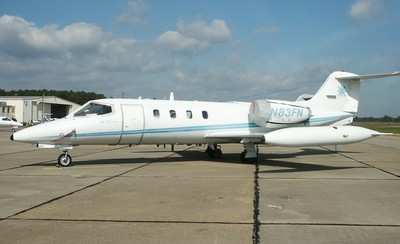 Eliminating “friendly
fire” accidents is a priority for the American military. A
giant leap forward was recently made in this effort due to a very
successful joint test flight made at a Naval Air Station Patuxent
River flight test range. The Navy, Air Force, and Federal Aviation
Administration (FAA) joined together to examine a new
Identification Friend or Foe (IFF) system known as Mode 5.
Eliminating “friendly
fire” accidents is a priority for the American military. A
giant leap forward was recently made in this effort due to a very
successful joint test flight made at a Naval Air Station Patuxent
River flight test range. The Navy, Air Force, and Federal Aviation
Administration (FAA) joined together to examine a new
Identification Friend or Foe (IFF) system known as Mode 5.
The current system used by the U.S. military and NATO allies,
known as Mode 4, has several critical challenges that the
replacement Mode 5 promises to solve. This upgrade provides the
warfighter unprecedented security, performance, increased mission
effectiveness and a lower possibility of misidentification of
friendly assets.

The Mode 5 IFF system is made up of two key components: an
interrogator and a transponder. A ship or aircraft with an
interrogator has the ability to send out a secure signal that only
transponder-equipped platforms can decode. These platforms can in
turn respond, providing a positive identification as a friendly
asset. This significantly enhances the warfighter’s
information about the battlespace, and decreases the possibility of
misidentifying a friendly asset.
The Air Traffic Control & Combat Identification Program
Office is managing the acquisition effort for this new Navy
capability. Planning for this flight test began approximately three
years ago and culminated in October with the successful application
of Mode 5 on three separate aircraft as well as two ground
stations, according to the Navy Flight Test Lead Ken Senechal. The
other team members were Capt Meghann McNiff from the Air Force and
Andy Leone from the FAA.

Mr. Senechal described the testing process as “great
cooperation between the Air Force and Navy which led to a highly
successful flight test that occurred on schedule and accomplished
all the objectives on the first try.” It is unusual for Navy
program offices to test a product in a joint environment for the
very first test, but the opportunity was hard to resist.
The Air Force offered the E-3B Airborne Warning and Control
System (AWACS) aircraft, which added an aircraft with an
interrogator that the Navy would not have had as part of the
testing,” said Mr. Senechal. The Navy provided P-3 Orion and
Lear Jet assets, as well as the ground stations at NAS Patuxent
River and Webster Field in Maryland.

The team flew three separate flight tests to capture enough test
data to get meaningful results, though six flights were scheduled
in case of problems like inclement weather. The three flights were
so successful and the cooperation among the participants was so
strong that all parties agreed to end the test after the third
flight, declaring the entire test a success.
This was the first developmental test, but many laboratory tests
preceded the flights. In fact, there is an ongoing cooperative
effort to test this system in a lab environment with the Italian
Ministry of Defense, which has also proven very successful and has
provided critical data for the testing office.
In addition, the flight tests provided necessary data concerning
azimuth accuracy, range accuracy, resolution, platform
identification number support, Combat Identification integration
into the fire weapon control systems, timeliness, and compatibility
with the civil air traffic control system.
The program plans continued testing under operational conditions
next spring; flight tests with the Italian military next summer;
technical evaluation in 2006, leading to initial operational
capability scheduled for 2007.
 SpaceX to Launch Inversion RAY Reentry Vehicle in Fall
SpaceX to Launch Inversion RAY Reentry Vehicle in Fall Aero-News: Quote of the Day (04.23.24)
Aero-News: Quote of the Day (04.23.24) Aero-News: Quote of the Day (04.20.24)
Aero-News: Quote of the Day (04.20.24) ANN's Daily Aero-Linx (04.20.24)
ANN's Daily Aero-Linx (04.20.24) Aero-News: Quote of the Day (04.21.24)
Aero-News: Quote of the Day (04.21.24)






